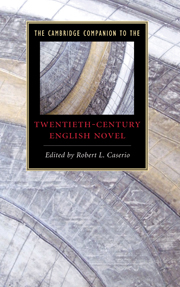Book contents
- Frontmatter
- Introduction
- 1 The art of English fiction in the twentieth century
- 2 The British Empire and the English modernist novel
- 3 Realism and rebellion in Edwardian and Georgian fiction
- 4 The Great War in English fiction
- 5 Postwar modernism in the 1920s and 1930s: The mammoth in the basement
- 6 Regionalism in English fiction between the wars
- 7 Ireland and English fiction
- 8 Feminist fiction
- 9 Working-class fiction across the century
- 10 World War II, the welfare state, and postwar “humanism”
- 11 The Windrush generation
- 12 History in fiction
- 13 Postmodernisms of English fiction
- 14 Detectives and spies
- 15 The post-consensus novel: Minority culture, multiculturalism, and transnational comparison
- 16 An absurd century: Varieties of satire
- 17 The other side of history: Fantasy, romance, horror, and science fiction
- Further reading
- Index
7 - Ireland and English fiction
Published online by Cambridge University Press: 28 July 2009
- Frontmatter
- Introduction
- 1 The art of English fiction in the twentieth century
- 2 The British Empire and the English modernist novel
- 3 Realism and rebellion in Edwardian and Georgian fiction
- 4 The Great War in English fiction
- 5 Postwar modernism in the 1920s and 1930s: The mammoth in the basement
- 6 Regionalism in English fiction between the wars
- 7 Ireland and English fiction
- 8 Feminist fiction
- 9 Working-class fiction across the century
- 10 World War II, the welfare state, and postwar “humanism”
- 11 The Windrush generation
- 12 History in fiction
- 13 Postmodernisms of English fiction
- 14 Detectives and spies
- 15 The post-consensus novel: Minority culture, multiculturalism, and transnational comparison
- 16 An absurd century: Varieties of satire
- 17 The other side of history: Fantasy, romance, horror, and science fiction
- Further reading
- Index
Summary
Aesthetic and political struggles shaped fiction writing in Ireland in the twentieth century. Twin but warring needs impelled the contestation. Writers sought to institute a discrete and purpose-built tradition that could mirror and meditate divisions and ideological conflicts endemic in a colonial society and that could treat the traumatic effects of a postcolonial legacy. Yet writers also chafed against such imperatives and resolutely endeavored to escape them. Whereas the English novel was seen as determined by an unbroken lineage rooted in seventeenth- and eighteenth-century antecedents and nurtured by a stable and flourishing bourgeois society, the Irish novel in lacking such accouterments was found wanting. In particular, Irish political ruptures with England in the nineteenth century meant that the conventions of realism did not readily establish themselves. They seemed ill-suited to novelists' aims to render dissension and social upheaval. Instead, absurdist fables, political allegories, Gothic romances, metafictions, peasant tales, and versions of what R. F. Foster has dubbed “the Irish story” took the place of realism.
Sean O'Faolain provocatively claims in his autobiography that “there is no such genre as the Irish Novel.” In making this polemical assertion, he does not dispute the achievement of individual Irish authors but laments the absence of a continuous, overarching literary tradition. Colm Tóibín launches a similarly devastating broadside in his account of the vicissitudes of the novel in Ireland. Tóibín holds that fiction is preempted by the already fabulous nature of Irish history, with its dependence on tragic denouements and heroic narratives; and that conflict-laden political realities in the country have loaned themselves more readily to fragmented stories than to the cohesive vision demanded of the novelist.
- Type
- Chapter
- Information
- The Cambridge Companion to the Twentieth-Century English Novel , pp. 102 - 113Publisher: Cambridge University PressPrint publication year: 2009

